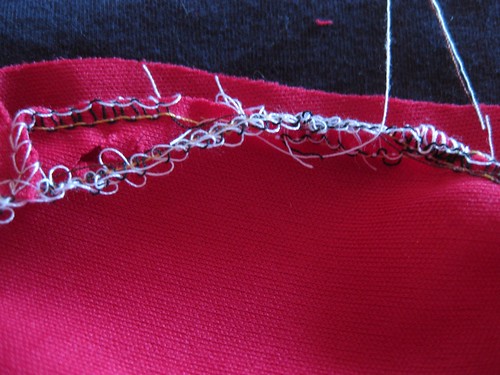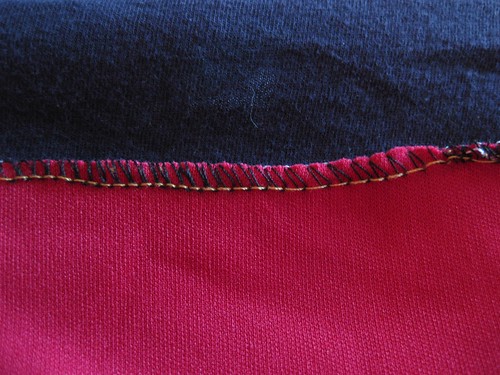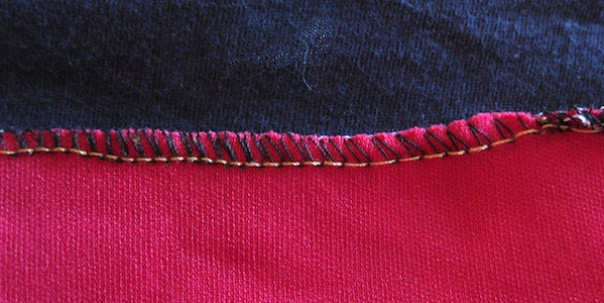Recently, I got a new-to-me serger.
Armed with lots of enthusiasm, and a solid working knowledge of sewing, and a dog eared manual, I got started.

There were trials and trials, and more trials.
I broke down, and rethread the one spool that was not engaging in the stitch.
That did not help.
So I regrouped and was brave enough to actually rethread the whole machine! Gasp! I did it! (As those of you who have one know, this is no joke. There are lots of little hidden holes to work the thread through. But I did it!) I figured it was a good learning experience regardless of it’s success.
Alas, there is still an issue.
The brown thread is still not engaging.

You can see here, it is not picking up, and incorporating into the stitch.
And the tension is not right in the best of the trials.

Not bad. But still missing one of the 4 threads. And the black is over the edge (meaning the white is pulling too tight on the other side.)
Now, I am at a standstill. And questioning my strategy. Do I have it threaded correctly? How do I fix the tension issues? Is this a mechanical issue?
Next step: I am looking around for private lessons. I am not sure if I should have the machine serviced at a repair place, to make sure that it is not broken before the lesson. That would probably run about $100 – $200. Is that worth it? The last post was “Which came first, The lesson or the serger?” This post is “Which is culprit, broken machine or user error?”
© 2005 – 2012 Kathy Lewinski & Susan Cornish






Susi,
I am sorry that I came late to this discussion. Here in NYC, we have plenty of opportunities to take classes at sewing centers to learn basic sewing, etc. When I was in Tampa, I took such a class because I didn’t know what type of machine that I wanted to buy. The only problem is that they try and push their own machines rather than recommend something (brand) that they don’t carry. This was probably the most important class that I could take because of my compulsive nature I would have bought the high end Bernina when a simple 18 stitch Brother was suitable.
I would look for a lesson first before getting the machine serviced. Tell your teacher the situation and if she/he is good they should only charge you gas money if your machine is broken (or at least a credit towards a future lesson). I would hate for you to spend money on a machine consultation if it doesn’t need one (and they would certain charge you rather your machine is broken or not–or they would find something to change in order to charge you money).
Sorry for the long reply–but my two cents worth. All the best–(dr)Russ
No help from me, just sympathy. This is the sort of situation that keeps me from sergers.
first, no offense meant to previous commenters, but if you try to take a class when your machine is broken, you’re wasting time, yours and theirs. i sincerely hope that they would charge you for the class, not just gas money, because they cleared their schedule for your class. it’s not their fault you didn’t ensure that the machine was in good working order. in fact, most classes will say that your machine must be in good working order to even register.
but even without considering the teacher’s feelings, i would get it serviced first. you’re not a sewing newbie, you know how to follow a manual, there’s obviously something screwy going on with the machine. tension can very easily get messed up, and will drive you insane until it’s fixed.
a basic servicing shouldn’t even come close to $200. really?! i’ve never come across anyone who pays as much for sewing machine servicing as we do in vancouver, and the place i go to only charges $85 or $95 for the non-electronic sergers.
even if there isn’t anything wrong with the serger, and it does turn out to be user error, they’ll be able to tell you what you’re doing wrong, and your new-to-you serger will be all nice and clean and healthy! take samples of what problems you’re having, so that they’ll be able to see, and leave it threaded when you take it in, so they can see how you threaded it. if you don’t want to leave your spools of thread at the repair shop, cut them at the spool, so that a length of it stays threaded.
there are so many awesome things that you can do with a serger, so taking a class can definitely be something to think about in the future, but for now, just play with it. you want to be comfortable with your machine before you start trying fancy stuff anyway.
also, watch for books about serging at thrift stores and 2nd hand stores. there seemed to be a ton of books about serging techniques that came out in the late 80s/early 90s, and i see them a lot. the fabrics and projects might be hideous, but the techniques are still awesome!
i’m sorry for the super long comment! i’ve had a serger for more than 10 years, and they’re awesome. people are so intimidated by them, but they’re not nearly as scary as you think!!
Our local sewing machine shop does tune ups on sewing machines. I would recommend taking it to some place like that. That way you can also make sure it’s well oiled and everything.
To clarify, if you let the teacher know in ADVANCE what the problem is, many people will work with you if the machine is the problem. We are talking about a one-on-one consultation.